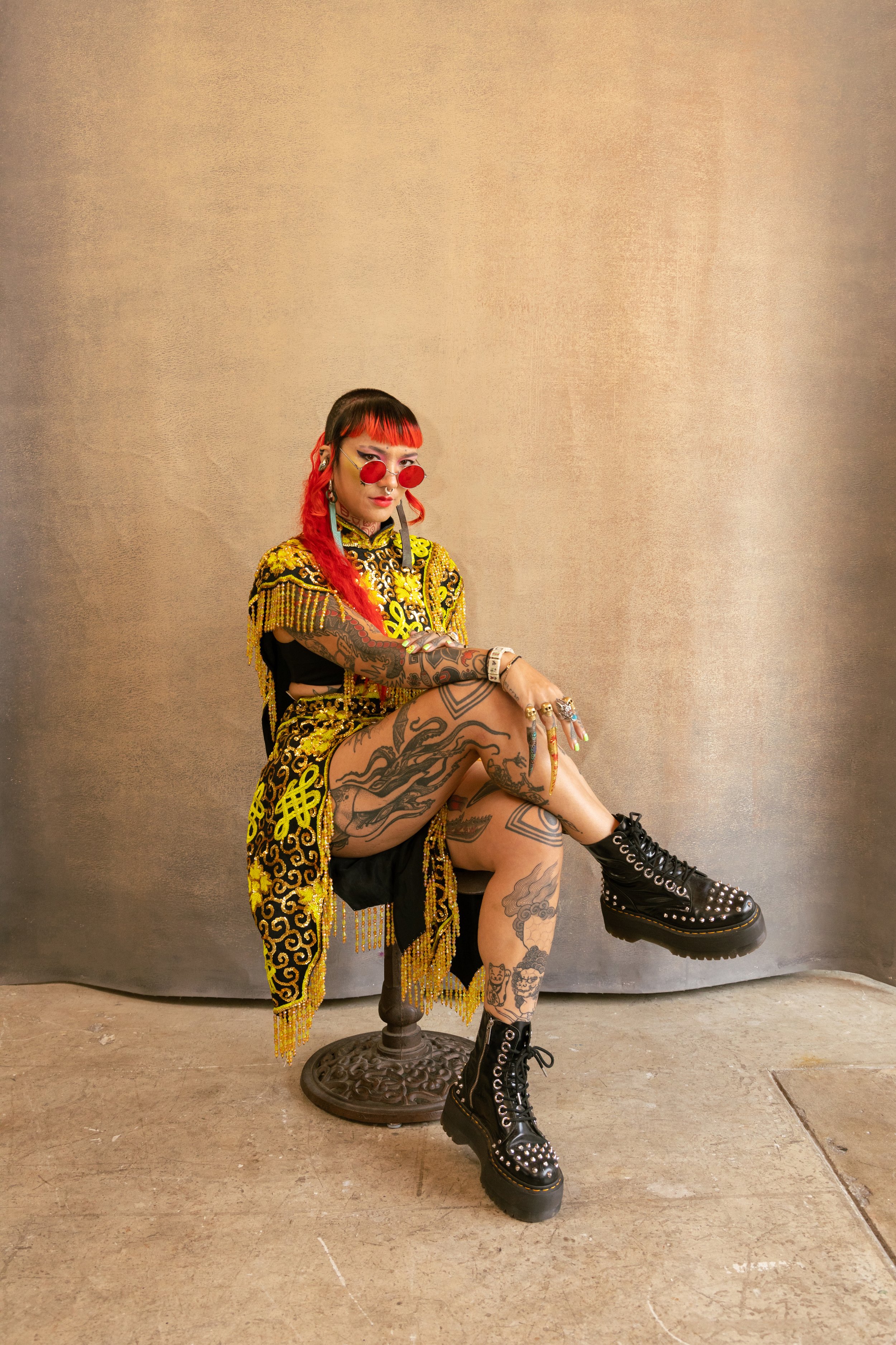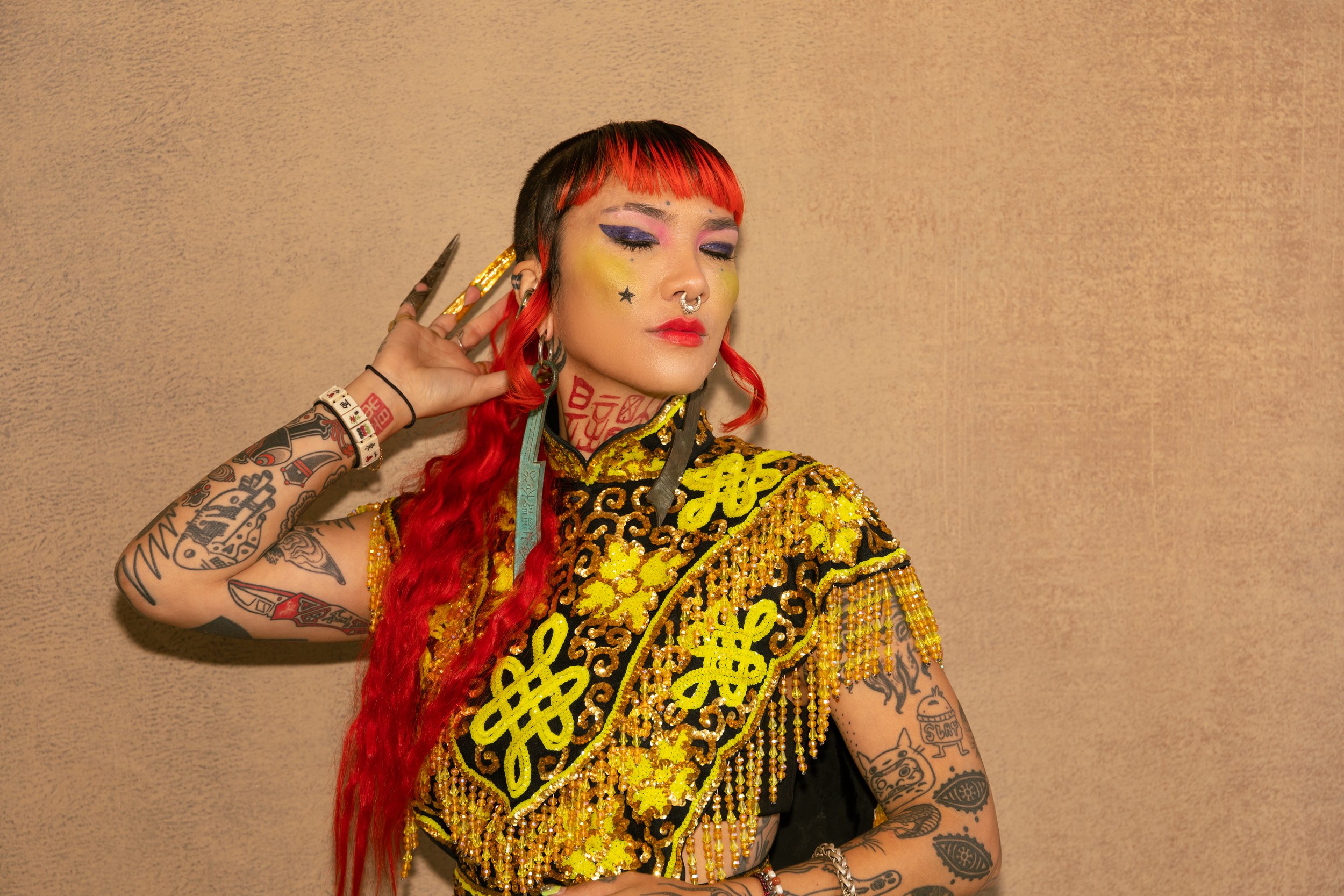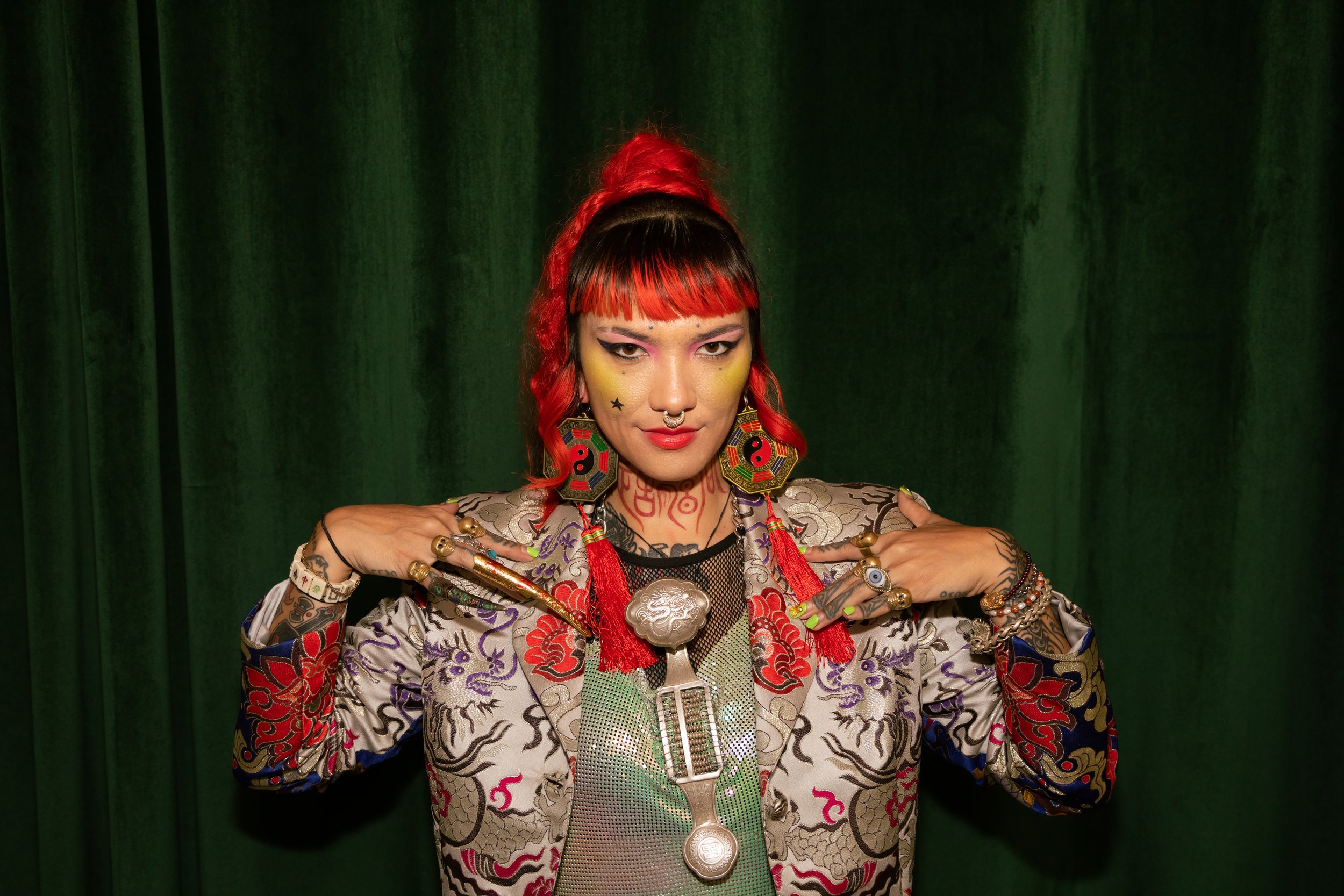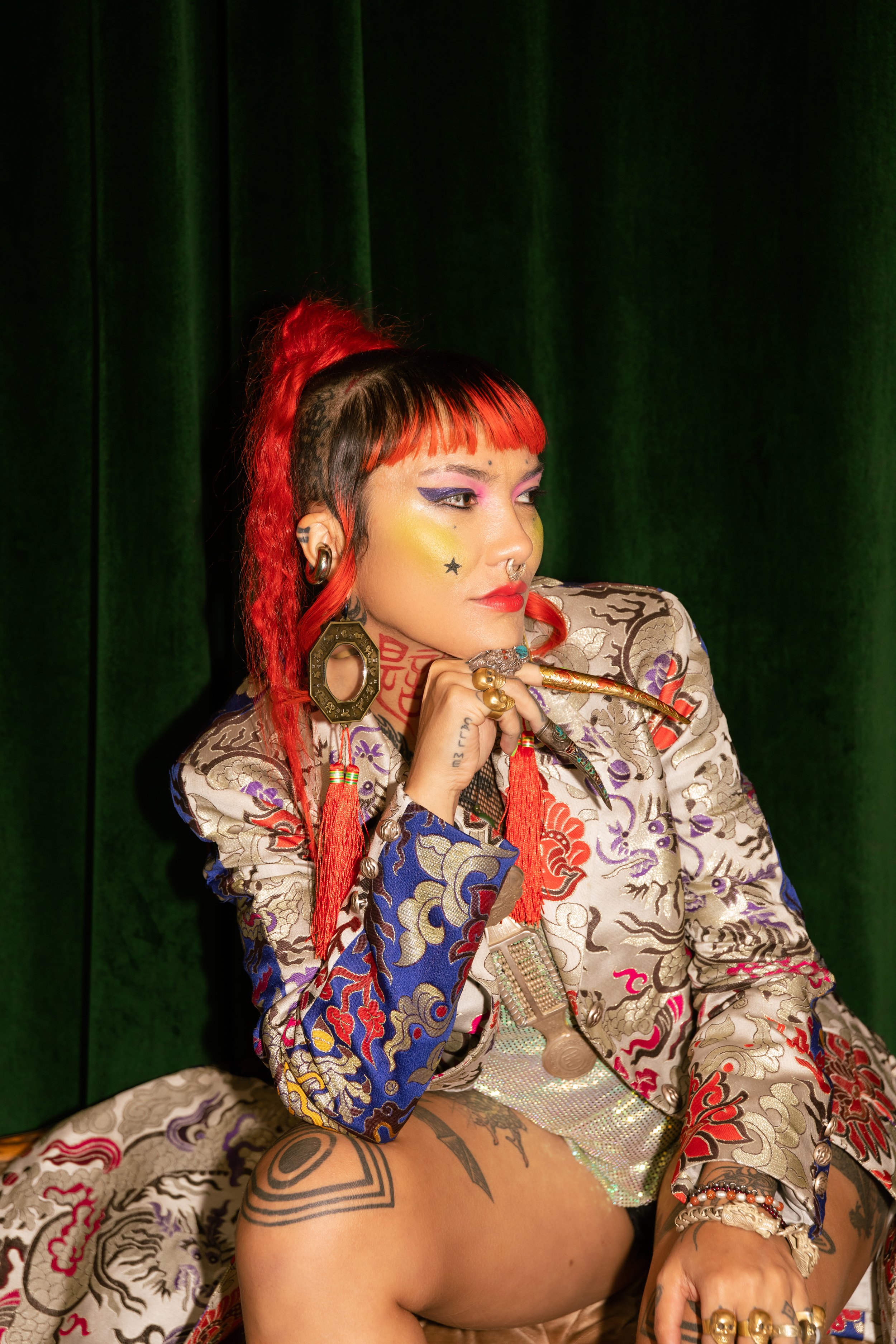Lauren YS, Always Evolving
⤏ ARTIST LAUREN YS ON THEIR DECADE LONG CAREER, ARTIVISM AND AVOIDING BURNOUT
⤏ IN CONVERSATION WITH JIREH DENG
⤏ PHOTOGRAPHY BY DANIEL HERMOSILLO
⤏ STYLING BY PETER LAI
⤏ MAKEUP AND HAIR BY KATIE MANN
As a second-generation Asian Angeleno walking through Los Angeles Chinatown, I feel a mix of emotions. Pride and love for this neighborhood that is visually and ethnically so Chinese. Yet estranged from this neighborhood because I wasn’t born here, but rather in the Chinese American suburbs of the San Gabriel Valley, and my connection and heritage to it is largely imagined. But I feel troubled by all the gentrification that is pushing out older Asian residents and forced to act.
All of these feelings are encapsulated whenever I walk past a large mural of two neon blue tigers in Chinatown. The words above read, “Stop Asian Hate Crimes” and just next to it, “Protect Our Elders.” The LA-based artist Lauren YS is a muralist and painter who has been using their art to bring visibility to Asian American issues. And during the pandemic, that effort took on a heightened sense of urgency. That’s where LA’s Chinatown mural came from and where other works popped up across the United States. Even in New York City Chinatown’s Yu & Me bookstore, I recognized postcards of Lauren’s artwork which I brought home to LA.
Lauren’s work is immediately recognizable in style, neon colors, and alien and queer-looking characters inspired by Chinese mythology. After a decade of working as an artist full-time, Lauren looks back at where their journey has taken them. So much of their artivism is a reflection of their mixed Chinese ancestry, their queer identity, and politics. As they look towards the future, we talk about their anticipation of new mediums they want to explore and their caution around the growing proliferation of artificial intelligence in the art world.
JIREH DENG: I know you’ve been working on a couple of different things, new murals and also a rebranding of the platform @squi.tropica where you were highlighting the work of LGBTQIA+ and BIPOC artists. Can you talk about some recent updates in your artwork?
LAUREN YS: I’m at the point in my career where I’m 10 years in so I’m doing a big overhaul of looking back on why I started and the things I wanted. I’m interrogating where I want to take things next, what has stability and potential. My partner and I started the @squid.tropica page as a fun thing to do during the pandemic and have been running it now for two to three years. I’ve been thinking about getting a nonprofit status to apply for grants, but I didn’t feel like the name was serious enough. @squid.tropica was a combination of my handle, @squid.licker and of my partner’s @polartropica and I also want to deflect attention away from myself. The intention was always to uplift other queer artists of color. Now it’s called @theleveretspirit after Tu’er Shen who is the rabbit God and protector of queers in Chinese mythology. I’m excited to see the new energy it brings. I suppose I’m doing the same thing with my own work, I don’t know just yet whether it’s going to be a style change, a shift in intention, or a process.
I just painted a big piece in Montreal for the MURAL festival and they were really lovely. I decided to do a Pride piece that wasn’t necessarily tied to Pride month, but I wanted to acknowledge the kink scene and the strong queer history within Montreal. I always forget that the non-queer world isn’t like the queer world in the way that everyone’s an alien or presenting a different persona. We’re used to looking crazy and feeling crazy as we interrogate our bodies and how we move through the world. In this mural I wanted to paint more of these alien-esque proportions with costumes just to bring a bit of gay into the streets. It was great because I went to a LATEX rave here and when I walked into the party it looked like my mural everywhere.
JD: What does a normal day look like for you as an artist when you wake up in the morning and start working?
LY: My days are really disparate. If it’s a day when I’m painting a mural, I will get up really early and paint for 12 hours and not stop. That’s why my murals take me like six days because it’s non-stop and I won’t do anything else. Then afterwards I pass out for a day or two and I get really slow, I have to recover. So there’s these really crazy spurts of work and lots of lazy days where I’m milling about, thinking about things, or drawing in a cafe or planning. It’s really imbalanced and that’s something I’m trying to work on as I get older, I’m trying to find more consistency. But it’s normal for muralists to have really intense periods and then periods of gestation and rest. I’m learning that I need to go to a spa and get massages and stuff like that. But I’ve been focusing more on just taking care of myself and not paying as much. I don’t drink, but I go to things that bring me inspiration like going to LATEX, or checking out the city, meeting people, hiking and stuff like that. I think it’s just part of being human for anyone.
JD: I have to ask, the nature of your work is very labor intensive and physically taxing on the body. Murals are extremely vulnerable to being whitewashed or being defaced. What is it like having to let go of the permanence of your murals knowing that it’s meant to eventually disappear over time.
LY: That's just something you have to accept about the nature of our industry. I’ve had to cope with it over the last 10 years and I’ve never had too much trouble with it. But there are a couple of pieces I was really sad to lose like a painting of my grandparents in Honolulu’s Chinatown where they met. It was really sad to lose it because it was buffed and now it’s just a white wall. Some murals feel really powerful because of the context and research I did and it hurts to lose those. But oftentimes if someone paints over me and does a better job, I’m not upset. That’s the whole point, I’ve painted over other painters and you get used to it. It’s just shifting over time. That’s also why I paint so much, because you know that you’re going to lose pieces. The fact that it’s ephemeral means that there’s always potential to grow. You also need to stay active and push yourself to think of the next thing rather than depending on the last piece you did. I think the best artists are the ones who are never totally happy with the last thing they did even though that’s torture. You have to continue to evolve. One of the best lessons about being a human is learning to let go of things. I walked past my mural in Montreal yesterday and it’s already tagged. I knew that was going to happen because Montreal is pretty wild. We paint in public spaces and I use spray paint. The fact that I am able to paint murals comes from the graffiti world, and I have a lot of respect for graffiti. So you can't get mad. You just adapt and keep moving.
“ I think the best artists are the ones who are never totally happy with the last thing they did even though that’s torture. You have to continue to evolve. One of the best lessons about being a human is learning to let go of things.”
JD: That makes a lot of sense. What really stands out to me about your work is its groundedness. Whenever I see your mural in Chinatown, I feel so rooted in a physical space. I wanted to ask how you incorporate community feedback and do research on what people need when you’re commissioned to do a mural.
LY: It really depends from project to project. If I'm painting and it’s related to sea walls, climate change and ocean issues, then they literally give you a deck where you chose a topic from. So I think, “Okay, how do I talk about plastic waste within my visual context.” But when it's more open, I really like to do research about regional mythology. I think it's important to have contextual evidence in your piece and be inspired by the things around you. Sometimes it's politics or the local community. The first time I was painting in Japan I [painted] a samurai. The second time I was much more free and I took inspiration from all the different places I visited. I wanted to create a scene where all these different characters I was drawn to while traveling could show up and sit together in a cafe. I included a Neko cat because I went to a Maneki Neko shrine and also a deer goddess I invented from Nara. I channel a lot of things I see and I’m a conduit for the spaces I’m in. Every artist is different and it’s neat to see where people get their nodes of inspiration.
JD: Your style to me is very otherworldly and alien with all these intense bold colors. But each one of your murals is unique in its own way where you’re trying to tell a story. How have you kept yourself inspired artistically but also motivated and not burnout over the past decade?
LY: That's a really good question. It's really important to always see yourself as an artist when you're in the world, note that anything can be a source of inspiration. Even while you’re just walking through the streets and see something in the window, write it down and take a photo even if you don’t know why you were drawn to it. I think I’ve found more and more inspiration from the world around me rather than Instagram. Everything is so oversaturated with so much art being created and it can be really overwhelming. I find it really helpful to shut that out and just dig around in my own mind. I take out my sketchbook and draw without any references, I just sit in my bed and figure out what’s in there.
I get huge amounts of inspiration from Chinese mythology because that was sort of my way of connecting to my culture. I don’t speak Chinese and I don’t have my grandparents anymore so I turn to things like mythology and symbols. I had a Bazi reading done recently and learned more about my zodiac animals and I had a ton of ideas from that. There’s a constant sense of searching for inspiration because a painting should never feel like a job, it’s always an honor. But it does get rough. I was really inspired by social justice work for a minute and I always am, but it’s hard to be in that work and not get really depressed because it’s so heavy. I had to learn how to shut things away for my mental health and I think that’s a huge process for anyone in social justice work.
JD: Your artwork has always stood out to me because of its activist bent and putting queerness in the forefront of our imaginations. I imagine it’s difficult as an artist looking for sources of funding to make art. What is your relationship to institutions and trying to make art under constraints while also trying to resonate with audiences.
LY: It’s a bit tough because as activists we’re led to naturally mistrust institutions and corporations. Especially where money is involved, there’s always sketchy stuff going on. But we also rely on institutions to prompt and support us. I definitely think it is the institutions’ responsibility to be sourcing artists who have important things to say and to pay them properly and take care of them properly. I’ve had some really nice experiences like painting at the Yale Asian American Community Center. Then there’s the pitch I’m working on for an institution in California where there’s no funding. I have to negotiate through this process, I can do this for free, but I can’t pay out of my pocket to rent a lift.
I went to Stanford on a scholarship and I understand how much money universities have. Especially if you’re doing work that involves promoting the Asian American identity or culture it doesn’t look good when you’re making artists work for free. It’s important for institutions —like museums— to understand that if you’re out there promoting art then support artists the same way. It’s difficult running the game and drawing the boundaries around what you are willing to give. I’m an artist, I’m really bad at contracts and money stuff. I always want to paint things, but if you let yourself get run over all the time, you won’t be able to build yourself. I’m still learning, but the most important thing is not to lose the love you have for what you do.
“There’s a constant sense of searching for inspiration because a painting should never feel like a job, it’s always an honor.”
JD: How does identity factor into your artistry and self-expression?
LY: Outside of the queer community I talk about being gay all the time, but if you’re not within the community everyone assumes I mean lesbian. I have to explain, “No, gay means literally everything.” It’s such an insanely massive term and so is queer, within that I identify as pansexual. All these terms are so funny because people are afraid to talk about them or misgender you. But my pronouns are most just an open door for me to have conversations about what the binary is and what it means to be gender fluid. I used to be really angry at people when they mess it up, but it’s not worth the energy. I really appreciate when people do get my pronouns properly but even more so when someone asks, “What do they mean to you?” Defending other people’s pronouns and descaling any transphobic or restrictive ideas around the binary is really important to me. I think we’re in a space where we’re still redefining all these things. Young people are so cool because it’s just second nature to them. I feel really excited in a strange way for the next generation because older folks sort of look up to them.
I also want to talk about how queer people and people of mixed race present themselves in fashion. A lot of what I’ve been working on in the past years straddles the line between my art and my personal life through how I present myself to the world. I wear a lot of clothes I got from China or Hong Kong and my haircut is a symbolic reference to the Manchu cut. It’s my way of manifesting my heritage through the way I look. In this photoshoot I’m wearing items from Peter Lai’s studio. He is one of my good friends from Hong Kong who’s an amazing queer fashion designer. He would hate it if I call him my elder, but he’s older. Wearing his work and promoting it through this photoshoot is important to me because it’s part of protecting elders. Peter inspires me because he’s an older person who just loves his art and never compromises. He’s proudly queer and super Asian. So if anyone is in LA and wants to visit his studio, he's on Instagram as peterlai_asian_village. He understands my style intuitively and I’m really happy I got to borrow those items for this shoot.
JD: You’ve mentioned that you’re in this transitory stage at the 10 year mark of your artist journey. Are there any new things you’re trying at this stage in your career now that there’s maybe a little more security? Any new mediums that you’re experimenting with?
LY: Yeah, absolutely. I've really been thinking about expanding into different areas especially because eventually I won’t be able to bust out large-scale murals. Hopefully that won’t be in a long time, but being a muralist is tough on the body. I’ve been looking into screenwriting, tattooing, and installation work. My installation at Meow Wolf was one of the coolest things I’ve ever done and I would love to do more immersive experience art. I studied creative writing in school and my initial intention was to write books that could become graphic novels or videos and films, that’s why my work has so much narrative woven into it. Lately I’ve been thinking about pivoting back in that direction to make something more longform. It’s a fun time and a little scary. Now I have my art on lock, but how do I expand? How do I bring more richness into my world for people to experience? How do I do things that no one else has done yet? How do I break out of just static 2-D images? Is it just about going bigger and bigger? These are really important questions but I feel like anything is possible. It’s very exciting.
JD: Well now that you’ve brought up the dimensionality of art, I’ve been thinking a lot about artificial intelligence and its impact on how we perceive fine art. You’ve been in this art world for a decade now, are you concerned with how this technology might impact artists like yourself? How might AI start to cross into using the work of artists without their permission?
LY: This is a big topic I've been having a lot of conversations about. I'm not too worried. I'm more worried about the human race in general and how we consume visuals because I think it's already so oversaturated. It used to be so cool for me to imagine “What if this thing was made of jelly?” Figuring out how to do that was such a cool process and it made me feel magical and powerful. If viewers get so used to seeing literally anything possible, what will be special? At the same time, I am a firm believer that everyone’s a creator. I wouldn’t ever try to make someone stop creating with whatever medium. I’m excited that people are making things. But I don’t want creativity to be narrowed down to how good you are at writing a prompt. I think that’s so reductive and disruptive of the process. For me, I’m a hugely process oriented artist. I never use projectors for my murals, I freehand everything. So I do a lot of color play and intuitive stuff on the spot.
When I look at murals or any type of art that’s just product oriented, it feels so soulless to me. I’m hoping in the future there’s more value placed on our artists and artworks that have a really human process. I feel lucky that AI can’t paint murals, yet. But I don’t know, I am myself a type of AI. If you think about it, everything I make is just a weird combination of things that I thought of, but I’m human, I make mistakes. Part of questioning my process is asking if maybe I’ll reduce myself to something that is even less rendered and more imperfect and human. But we don’t have any control over it and we will have to see. I hate it, but I also see tons of AI shit where I’m like, “That’s fucking sick, that’s really dope.” So maybe it’s just a bigger challenge and we gotta roll with it.




